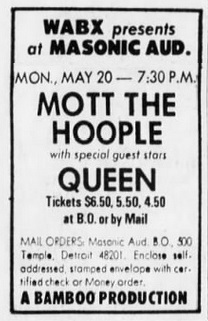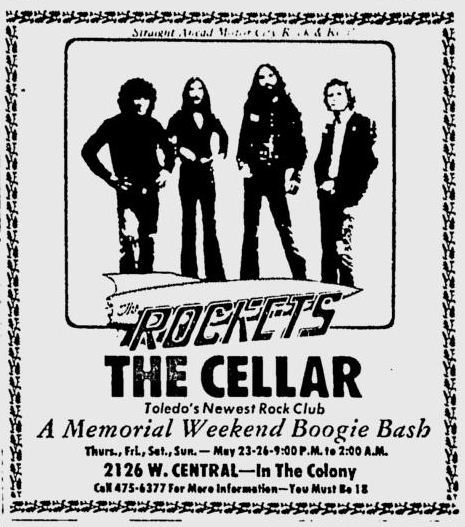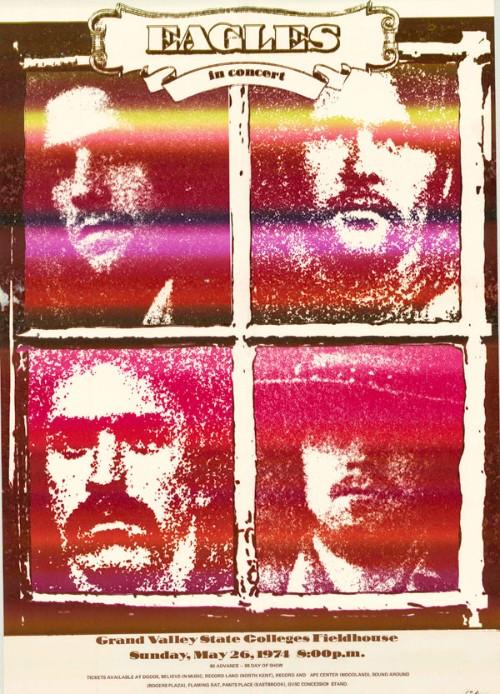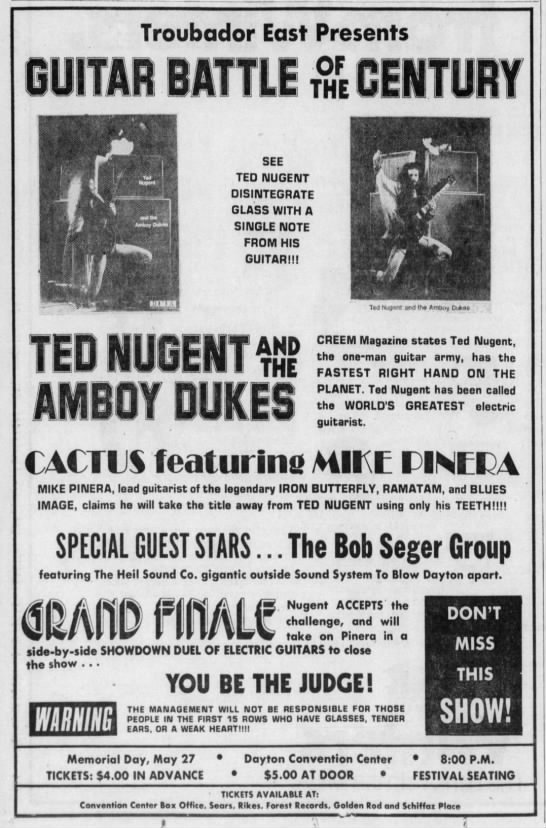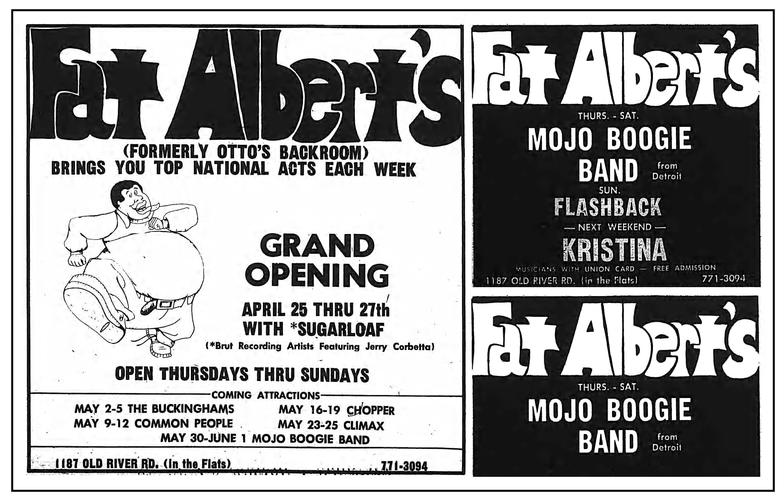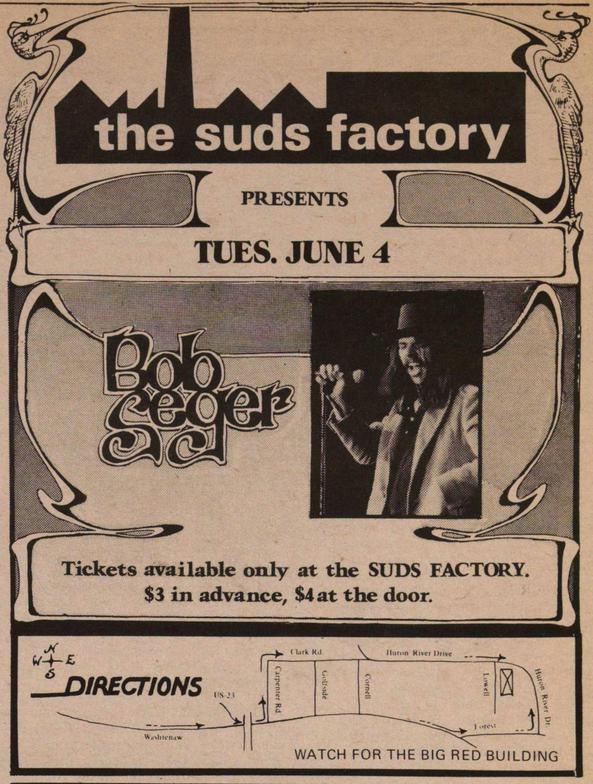Splatt Gallery
Double click here to add text.
Splatt Gallery's History of Michigan Music Posters
Volume Ten - 1974 - Page Nine
***********************************************************
A pair of ads for the Golden Earring tour in support of their ninth album (their first was released in 1965), “Moontan”, which included the hit single “Radar Love”. The ad on the left seems to be the later one as it has the updated information for two Michigan shows, in Flint on May 10, 1974, and in Detroit on May 19, 1974.
Golden Earring – Radar Love (1973)
https://www.youtube.com/watch?v=ckM51xoTC2U
Ad for Mott The Hoople at the Masonic Auditorium in Detroit, Michigan, May 20, 1974, with what would have been the first Michigan appearance of Queen, however, guitarist Brian May contracted hepatitis, collapsing just after the New York show on May 11, 1974, forcing the cancellation of all remaining dates on the tour. Their Michigan debut was delayed until February 1975.
Queen tour ad showing their intended show at the Masonic Temple in Detroit, Michigan, May 20, 1974, but all shows after May 12 were cancelled.
The “Last”, unfortunately, the final, issue of the Joint Issue newspaper in East Lansing, Michigan, May 20, 1974, ending a four-year run, part of the nine year history of East Lansing’s underground press that had begun with The Paper in 1965, one of the first five original underground papers in the country.
A two-page Columbia Records ad for Mott The Hoople’s seventh, and final, studio album, with tour dates including a show at the Masonic Temple in Detroit, Michigan on May 20, 1974, their fourteenth, and final, Detroit show, going back to November 1969.
They were touring with Queen as their backing band, and local ads for the Detroit show listed Queen as the “special guest stars”, but they were a last-minute cancellation for what would have been their first Michigan appearance. They were substituted by the band Kansas, in their first Michigan appearance. Oddly, when Queen does perform their first Michigan show, in February 1975, their opening band is Kansas.
Since this is the last time we’ll see Mott The Hoople, here is one last look at the group in action:
Mott The Hoople – All The Way From Memphis (live 1974)
https://www.youtube.com/watch?v=zvFpX98EOPo
A full-page Columbia Records ad for the debut album by Kansas, coinciding with the group’s first Michigan appearance, opening for Mott the Hoople, in substitution for Queen, at the Masonic Temple in Detroit on May 20, 1974.
A real nice poster by Hugh Surratt for Rick Nelson at The Brewery in East Lansing, Michigan, May 22, 1974.
Ad for the Masonic Auditorium in Detroit, Michigan, May 22, 1974, with a bit of a role reversal with Linda Ronstadt opening for her former backing band. It was the Eagles’ fourth Michigan appearance, their first as headliners, and Ronstadt’s second.
Jon Landau’s famous quote “I saw rock and roll future and its name is Bruce Springsteen” first appeared in print in the May 22, 1974 issue of The Real Paper, a Boston newspaper that published Landau’s review of a Springsteen show from May 9th at the Harvard Square Theater in Cambridge, Massachusetts.
Landau, who had produced the MC5’s second album “Back in the U.S.A.” became quick friends with Springsteen, becoming his manager and co-producer of his albums.
Newspaper ad for The Rockets, in a rare appearance outside of Michigan, although not very far outside of Michigan, and if you recall our earlier history lessons, once technically a part of Michigan, which is all a very long way to say Toledo, Ohio, at The Cellar, May 23-26, 1974, for four shows over the Memorial Day weekend. Like the ad says, “Straight Ahead Motor City Rock & Roll”.
Poster by Hugh Surratt for Dion at The Stables in East Lansing, Michigan, May 23-25, 1974.
A show that could be added to the concert database, Bob Seger at The Joint in the Woods in Parsippany, New Jersey on May 24, 1974.
A full-page RCA Records ad for the Guess Who’s album “Road Food” and the tour itinerary in support of the album, with a show at the Masonic Auditorium in Detroit, Michigan on May 24, 1974.
A glimpse into the future of Detroit rock and roll, although nobody knew it when this story on “Bookie’s” ran in the May 25, 1974 issue of the Fifth Estate newspaper in Detroit, Michigan.
The New York Dolls made their fifth Michigan appearance, at the strange venue owned by Detroit Tigers pitcher Denny McLain, the Trading Post in Roseville, Michigan, May 25, 1974 (does not show up in the concert database, but does appear on the New York Dolls website with a photo of this ticket). They will return to the Trading Post again for three more nights in August, we’ll have a flyer and a link to photos on that one. Stayed tuned, only three months away.
The New York Dolls website also has them at a festival in Tampa, Florida, on the same date, but insinuates that they may have performed both shows, despite the distance between them, the site claims: “Note: 12-hour festival which began at 10:30AM, opening with the Dolls. They also performed in Roseville (MI) the same day 1,200 miles apart.”
An ad for a rare hometown show by Rare Earth, at Masonic Auditorium in Detroit on May 26, 1974.
Another great poster from the folks at Grand Valley State Colleges in Allendale, Michigan, near Grand Rapids, for the Eagles, May 26, 1974. It was the fifth Michigan show for the Eagles, going back to opening for both the Mahavishnu Orchestra and Yes in 1972.
Four nights before this show, the Eagles had headlined at the Masonic Auditorium in Detroit, Michigan, on May 22, with Linda Ronstadt opening for her former backing band.
A pair of ads for Roxy Music at the Allen Theatre in Cleveland, Ohio with Mike Quatro opening the show on May 26, 1974.
A poster with Brownsville Station appearing with ZZ Top, Boz Scaggs, Blue Oyster Cult, and Pelican Peace Band at the Iowa State Fairgrounds on May 26, 1974.
An ad for another “Guitar Battle” show with Ted Nugent & the Amboy Dukes facing off against Cactus with Mike Pinera, and special guest stars Bob Seger Group in Dayton, Ohio on May 27, 1974.
Newspaper ad with Brownsville Station headlining a show with the Strawbs and local band Left End opening in Akron, Ohio on May 29, 1974.
An ad for the Mojo Boogie Band, actually from Ann Arbor, but close enough, at the recently opened Fat Albert’s in Cleveland, Ohio, for a three-night engagement, May 30, 1974 through June 1st.
Helpful hints, as published in the May 31, 1974 issue of the Ann Arbor Sun newspaper in Ann Arbor, Michigan, the “Dope Capitol of the Midwest”.
A collection of drawings by Chris Frayne (Ozone) from the pages of the Ann Arbor Sun newspaper in Ann Arbor, Michigan, overlaid on the centerfold story in the May 31, 1974 issue about his brother George’s band, Commander Cody & his Lost Planet Airmen.
Two posters for Alice Cooper’s first full-length feature movie “Good To See You Again”, filmed during the 1973 Billion Dollar Babies tour, which had a limited release in late May 1974, notably in Broome County, New York, where the group had been banned from performing a show during the 1973 tour. Following a few screenings, film was pulled from distribution to be re-edited and was re-released in October.
We could have sworn that we had a link to the full movie, but all we can find at the moment is the film’s trailer:
Alice Cooper – Movie Trailer for Good To See You Again (1974)
https://www.youtube.com/watch?v=CWv4dCZFC1U
A pair of complimentary tickets for the Alice Cooper movie “Good To See You Again”.
The front cover of the June 1974 issue of CREEM magazine by Kevin Tolman with photo courtesy of MainMan Ltd. This appears to be Tolman’s first work for CREEM, whose work we’ve seen previously on ads for WABX radio.
David Bowie was the third “CREEM Mate of the Month”, appearing in the June 1974 issue of CREEM magazine, using the Guy Peellaert (“Rock Dreams”) painting for the “Diamond Dogs” album cover. This is the original version, before RCA Records blacked-out the very obvious protuberance between Bowie’s hind legs, and changed the freak show sign "Alive" with the word "Bowie".
The third regular feature that CREEM magazine introduced in 1974 was the “CREEM Dreem” which debuted with Maria Muldaur in the June 1974 issue (two previous “CREEM Dreem” features had been printed for dream bands).
Capitol Records ad for Grand Funk’s album “Shinin’ On” on the back cover of the June 1974 issue of CREEM magazine.
A full-page Bell Records ad for Suzi Quatro’s debut album in the June 1974 issue of CREEM magazine.
The subscription page in the June 1974 issue of CREEM magazine offering a copy of Stevie Wonder’s “Innervisions” album as a premium.
A full-page Motown Records ad for the “Diana Ross Live at Caesar’s Palace” album, released in June 1974, which Motown proclaimed as “Diana Ross Month”.
A full-page Motown Records ad proclaiming June 1974 as “Diana Ross Month”, “featuring a total marketing campaign” on the “Diana Ross Live at Caesar’s Palace” album, promoting not only “One of the most exciting live recordings you’ve ever heard”, but also “one of the most exciting packages you’ve ever seen!”
The packaging, designed and photographed by Ed Caraeff, featured a framed photo of Diana Ross on the front cover which opens up to reveal a fold-down strip of five 7"x7" photos.
Photographer, graphic designer, and illustrator Ed Caraeff had already established a large and impressive body of work before he created the album packaging and photographs for Diana Ross’ 1974 album “Diana Ross Live at Caesar’s Palace”. He may forever be best known for his iconic shot of Jimi Hendrix burning his guitar at the 1967 Monterey Pop Festival.
He created over 400 album covers for musicians such as Carly Simon, Creedence Clearwater Revival, Frank Zappa, Tim Buckley, Tom Waits, The Bee Gees, Leon Russell, the Doors, and many more, becoming close friends with Dolly Parton, Neil Diamond and Elton John.
His work for some of our Michigan-related records include the Stooges “Fun House”, Alice Cooper’s “Pretties For You”, and Rare Earth’s “Willie Remembers”.
Caraeff’s discography page on Discogs, linked below, notes that “his experimental infra-red photos on the inner spread of (Captain Beefheart’s) Trout Mask Replica album helped break the mold in sleeve imagery”.
https://www.discogs.com/artist/780987-Ed-Caraeff
Nineteen seventy-four was Ann Arbor’s Sesquicentennial (150 year anniversary) of the town’s founding. The Sesquicentennial Council produced a magazine for each month of the year based on different themes and featuring cover art by local artists. For the June 1, 1974 issue, the theme was “Ann Arbor As A Good Neighbor” with cover art by Rainbow Graphics artist Gary Kell.
An RCA Records ad in the June 1, 1974 issue of Billboard magazine for the single “Rock The Boat” from the debut album by The Hues Corporation. Just prior to the recording of the album, singer Fleming Williams from Flint, Michigan had joined the California-based group, providing the lead vocals for this track. Williams had been a member of the Flint, Michigan group called 21st Generations which had released a single on the local Tri-City label in 1970. He also released a solo single, produced by Choker Campbell on the local Better World label, also in 1970.
“Rock The Boat” reached #1 on the Billboard Hot 100 chart in July 1974 and is considered to be the first “disco” record to reach the top spot on the chart, although two instrumental singles, “Love’s Theme” by Barry White’s Love Unlimited Orchestra, and “TSOP (The Sound of Philadelphia)” by MFSB (which became the theme song of the “Soul Train” television show) had also reached #1 on the chart in early 1974, prior to “Rock The Boat”.
The Hues Corporation – Rock The Boat (1974)
https://www.youtube.com/watch?v=h2r59-Xmge4
21st Generations – I Need Love (1970)
https://www.youtube.com/watch?v=Eq0RCIKpHVY
Fleming Williams – Poverty Child (1970)
https://www.youtube.com/watch?v=exAm69_g4yE
Barry White & Love Unlimited Orchestra – Love’s Theme (1974)
https://www.youtube.com/watch?v=0If2j-egRm8
MFSB – TSOP (The Sound of Philadelphia) (1974)
https://www.youtube.com/watch?v=8CmVxBmPdfw
A newspaper ad for Grand Funk at the Forum in Los Angeles, California on June 1, 1974, along with a photo from that night of super-fan Ric Monez. A well-written concert review by Robert Hilburn uses Monez as the centerpiece of the story, recounting that in addition to his hand-made shirt, Monez had spent $40 to make a plague “To the World’s Best Rock Band”, which he presented to the band at their hotel just before the show.
“They just LOVED it! Don Brewer thought it was gorgeous and Mark Farner gave me a hug. They invited me to their party tonight…at Chasen’s. My, my.”
The article concluded with the following passage (which has later significance to this story):
“After the concert, Ric and his friends headed for Chasen’s, where they ignored the presence of such nonrock figures as Liza Minnelli, Robert Wagner and Natalie Wood to concentrate on plans to get to the airport in time to catch the 3 a.m. flight to San Diego.
“Why San Diego?
“Grand Funk was going to do a show there Sunday night and they wanted to be first in line.”
There is a widely circulated bootleg video that is primarily known as “Grand Funk Live at the Forum Los Angeles June 1, 1974”; often packaged haphazardly with additional Grand Funk documentary footage. We have the link below to just the 55-minute show, and knowing how notoriously inaccurate bootleggers are, we believe a commentator that claims the footage is actually from the following night, June 2nd, in San Diego (the show that Ric Monez headed off to) and that it was shot by Lynn Goldsmith.
Goldsmith was born and raised in Detroit, and although she moved to Florida for her high school years, she returned to Michigan to attend the University of Michigan in Ann Arbor. Graduating magna cum laude in just three years, she went to work for Elektra Records, where, in 1971, she met Joshua White and worked with him as a director for Joshua TV, the first company to do video magnification for rock groups at large venues.
In 1972, Goldsmith directed ABC's “In Concert”, the first rock show on network television. After directing a documentary piece on Grand Funk Railroad for ABC, Goldsmith made a film on Grand Funk called "We're an American Band" and eventually became the band's co-manager.
She gave that up to concentrate on photography, becoming one of the world’s most successful rock and roll photographers, with over 100 album covers to her name and some of the most iconic, well known, shots of a galaxy of music’s superstars.
Grand Funk – Live Concert (San Diego, California) (6/2/74)
https://www.youtube.com/watch?v=RgTtlmqHUmk
Poster/ad by Gary Kell for the Rockets and Zoom at the Labor Temple, aka Carpenter Hall, in Ypsilanti, Michigan, June 3, 1974. The First Zenta Church of Ann Arbor was having some degree of success with these parties at the hall, this was their fourth sponsored event there since their Thanksgiving Bash on April 6th. A Toke Time Production.
Nicely framed ad for Bob Seger at the Suds Factory in Ypsilanti, Michigan, June 4, 1974.
The night after Bob Seger performed at the Suds Factory in Ypsilanti, he appeared at The Brewery in East Lansing, Michigan, June 5, 1974. The flyer has one of the most common misspellings of Seger’s name, spelling it like the folk singer Pete Seeger.
Meanwhile, still in New York City, “DOG (Detroit rock & roll)” performed at Club 82 on June 5, 1974, The week before, Club 82 had presented Palace with opening act “Ms. Patti Smith”. Smith had been active in the NYC art scene for seven years, painting, writing, and staging performance art and poetry readings. She was living with her boyfriend, Allen Lanier, who was the keyboard player in Blue Oyster Cult, she was contributing lyrics for the band’s songs and was considering becoming their lead singer, but Lanier encouraged her to start her own group.
The Patti Smith Group, including guitarist Lenny Kaye, began performing in January 1974, and the fledgling group released their first single, a cover version of “Hey Joe”, backed with an original tune “Piss Factory” which was recorded on the same day that the Dogs were rocking Club 82, on June 5, 1974.
Patti Smith – Piss Factory (1974)
https://www.youtube.com/watch?v=y6aUbrZYjYE
People from Ann Arbor began frequenting the Shelby Hotel in downtown Detroit, Michigan to catch the performances by the Lyman Woodard Trio, and made arrangements to begin rock and roll shows in a downstairs room, soon to become known as the Rainbow Room. The Rockets with MC Righteous Bob Rudnick kicked off the opening weekend, June 5-8, 1974.
Poster for the first Michigan appearance by Jimmy Buffett on the lawn of the Student Center at Grand Valley State Colleges in Allendale, Michigan, near Grand Rapids, a free show on June 6, 1974.
Three shows by Bob Seger and Hot Lucy in suburban Detroit, at the Hockeyland in Frasier, June 6, 1974, the Yack Arena in Wyandotte on June 7th, and the Cultural Center in Plymouth on the 8th.
A full-page ad for Richard Pryor’s third album which was released just weeks before his four night stand at the Fisher Theatre in Detroit, Michigan, June 6-9, 1974. These were Pryor’s first Michigan shows as a headlining act, he had previously opened a Jazz Revue show at Cobo Hall in Detroit in February 1968.
“That Nigger’s Crazy” was released on the Partee Records label, an imprint of Stax Records, and although Stax was floundering towards eventual bankruptcy, the album reached the top of Billboard magazine’s R&B Album chart, staying at #1 for all four weeks of September 1974, and winning a Grammy for Best Comedy Album.
Pryor would return to Michigan during those weeks of September 1974, with an appearance at Hill Auditorium in Ann Arbor, and back to the Fisher Theatre for five nights.
An ad for a show by Grand Funk at Kiel Auditorium in St. Louis, Missouri on June 7, 1974, which displays all ten of their albums up to that point, all Gold or Platinum records, released over a four and a half year period.
Volume Ten - 1974 - continues - HERE
An ad for Procol Harum with the James Montgomery Band and Golden Earring at Masonic Auditorium in Detroit on May 19, 1974. It was Montgomery’s third Michigan appearance of the year, his first return to his hometown since moving to Boston to form the band. It was Procol Harum’s 30th Michigan appearance, and Golden Earring’s 13th.
An ad for another “Guitar Battle” show with Ted Nugent & the Amboy Dukes facing off against Cactus with Mike Pinera, and special guest star Wayne Kramer in Indianapolis, Indiana on June 7, 1974.



